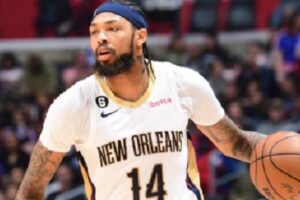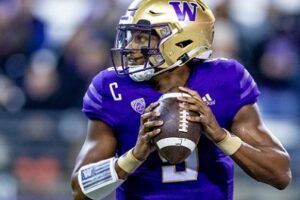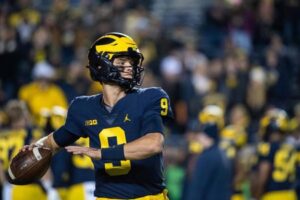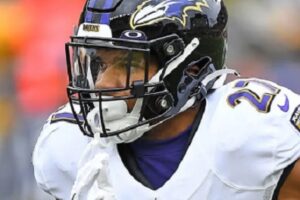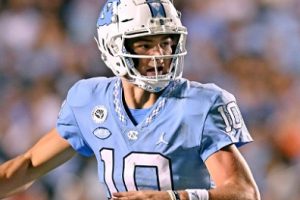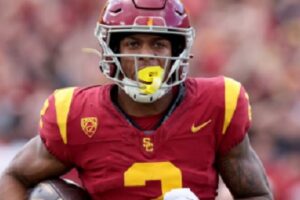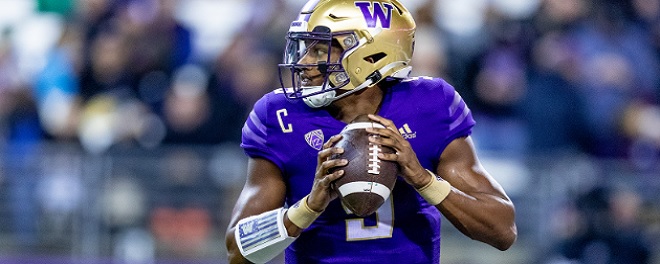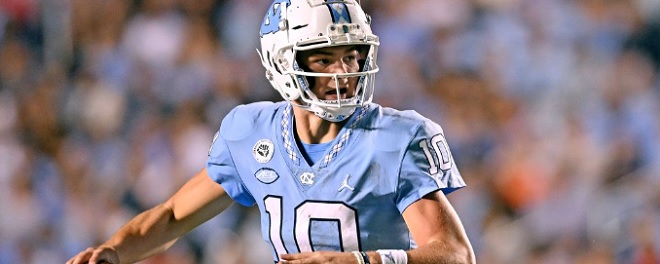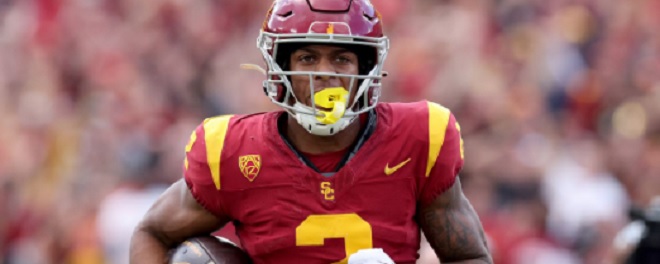By Charlie Campbell.
Send Charlie an e-mail here: [email protected]
Follow Charlie on Twitter @draftcampbell for updates.
This page was last updated April 12, 2016. Follow me @walterfootball for updates.
Position Review: Running Backs
Running Back Class
Early-round talent: B
Mid-round: B
Late-round: B+
Overall grade: B
2016 prospects vs 2015
Todd Gurley
Ezekiel Elliott
Melvin Gordon
T.J. Yeldon
Derrick Henry
Ameer Abdullah
Devontae Booker
Tevin Coleman
Duke Johnson
David Johnson
Kenneth Dixon
C.J. Prosise
Alex Collins
Matt Jones
Jonathan Williams
Josh Ferguson
The 2016 class of running backs is rather average. There is one elite prospect at the top and after that, there is some decent talent going into Day 2. It isn’t comparable to the 2015 class, however. A year ago, I gave the running back class an A grade because it was so strong at the top and deep into the mid-rounds. I wrote at the time, “In my opinion if he stays healthy, I think Todd Gurley could have a Hall of Fame career while Melvin Gordon will be in the Hall of Very Good.” This year’s draft class may have a player who has a great career in the category of very good and maybe the Hall of Fame with Ezekiel Elliott.
If you were to merge the two classes, Elliott is not as good of a prospect as Gurley but he is better than Gordon. The average grade on Henry isn’t as high as his former teammate Yeldon. Devontae Booker is on a par with Abdullah as a pick in the back half of the second round. Dixon, Prosise and Collins would be on a par with 2015’s third-rounders. Jonathan Williams and Josh Ferguson would go behind Matt Jones.
Safest Pick: Ezekiel Elliott, Ohio State

This was an easy choice as Elliott is one of the best players in the 2016 NFL Draft at any position. He was tremendous for Ohio State with his burst, vision, balance and ability to rip off yards in chunks. Elliott has the strength to run through tackles and pick up yards after contact with the burst to get to the second level. He also did some impressive blocking and receiving. Elliott looks like a three-down starter and a future Pro Bowler.
A year ago, I said that Gurley would be the safest pick if it weren’t for his torn ACL. Obviously, he had a tremendous rookie season after staying healthy. Gordon had a rough rookie year, but it definitely is too early to make any judgements on his career. Hyde has flashed at times for the 49ers, while Lacy had some good years before a down season in 2015.
2015 Pick: Melvin Gordon
2014 Pick: Carlos Hyde
2013 Pick: Eddie Lacy
Biggest Bust Potential: Kenneth Dixon, Louisiana Tech

Dixon could be a second- or third-round pick, so the team that drafts him will probably expect him to be a three-down starter in time. Dixon is a quality runner and receiver, however he is a jack-of-all-trades, master-of-none. He isn’t overly fast, big or physical. Dixon also demonstrated serious ball-security issues in college, committing far too many fumbles. I think that could be a problem as a rookie and get his career off to a rocky start.
This bust list is looking pretty accurate. Davis barely played as a rookie. Seastrunk never made it in the NFL, although he fell deep in the draft. Ball was a bust for the Broncos.
2015 Pick: Mike Davis
2014 Pick: Lache Seastrunk
2013 Pick: Montee Ball
Running Back Rankings by Attributes
Natural Running Ability:
NFL prototype: Adrian Peterson, Vikings
- Ezekiel Elliott
- Devontae Booker
- Alex Collins
- Kenneth Dixon
- Jonathan Williams
- Derrick Henry
- C.J. Prosise
- Josh Ferguson
Recap: There are still a number of coaches in the NFL who want an old-school approach of a running-based offense. Additionally, a lot of passing-led offenses want a back who can wear down defenses in the second half of games. All of these 2016 backs are quality runners.
Elliott is definitely at the top of the list. Throughout his college career, he was utterly dominant and demonstrated a great combination of speed and power. Elliott can run over defenders and break off long runs with a threat to score on almost any carry. His vision, feet, burst and balance are phenomenal.
Booker is a well-balanced runner with cutting ability, vision, patience and balance. He is a tough runner who can redirect and get north-south. Collins has very good vision with a balance of strength and quickness. He hits the second level quickly. Williams has excellent vision and is tough to bring down. He really finishes his runs well and is adept at weaving his way through the defense.
Henry is a north-south bulldozer with a burst to the second level. He has the power to run over defenders and the speed to break runs the distance. The reason why Henry is lower is because he lacks quick change-of-direction skills and is not elusive to dodge tacklers.
Prosise has a nice burst, cutting ability, and is a smooth runner. He isn’t as physical despite his size, but he has speed to the second level.
Ferguson is a fast runner with cutting ability, but isn’t going to be one to run hard or sustain a lot of contact in the NFL.
Pass Receiving:
NFL prototype: Le’Veon Bell, Steelers
- Josh Ferguson
- C.J. Prosise
- Ezekiel Elliott
- Devontae Booker
- Kenneth Dixon
- Jonathan Williams
- Alex Collins
- Derrick Henry
Recap: The passing-driven NFL has many offensive coordinators emphasizing running backs’ ability to help the aerial offense over their running ability. Coaches want backs who have good hands, run good routes and can rack up yards as outlet receivers. This was a really hard choice as the top five here are all excellent receiving backs.
Ferguson was a tremendous receiver as a sophomore and junior, putting up 50 receptions in each season. He had 38 as a senior despite missing a lot of time with an injury. Ferguson is a good route-runner with soft hands and uses his speed to get open. He could thrive as a third-down back.
Prosise is a former wide receiver, so obviously he has receiving talent. He can run good routes with nice hands.
Elliott, Booker and Dixon are excellent receivers out of the backfield. They run good routes and are extremely difficult for linebackers or safeties to cover. Each one should be a nice weapon as a third-down back in the passing game in the NFL.
Williams, Collins and Henry are the bottom three, but that is mainly because of a lack of opportunities. Arkansas didn’t pass the ball to its backs much, while Kenyan Drake was Alabama’s receiving back. Williams and Collins both have looked good catching passes in pre-draft work. Henry did well at the combine as well. This trio might need a more development in the passing game, but they all should be solid once they gain experience.
Pass Blocking:
NFL prototype: Matt Forte, Jets
- Ezekiel Elliott
- Derrick Henry
- Alex Collins
- Kenneth Dixon
- Devontae Booker
- C.J. Prosise
- Jonathan Williams
- Josh Ferguson
Recap: This is huge for offensive coordinators. If a running back can’t pass protect, he is going to have a hard time seeing the field in the NFL. When defenses know that a running back isn’t trusted to protect the quarterback, it is an immediate tip about what the play is going to be. Coaches want multiple backs with pass-protection skills. The importance of blitz pickup and pass blocking is increasing every year for running backs. The college game has caught on to this, and the 2016 group of running backs is well-prepared.
Elliott is my favorite of these backs in blocking for the quarterback. and he was outstanding at this for a college player. Elliott will take on linebackers and was very reliable at protecting his quarterback. Not only did he do a nice job in blocking for his quarterback, Elliott was an impressive blocker when others ran with the ball or caught passes. He was superb even when the ball wasn’t in his hands.
Henry showed massive improvement as a junior. Lane Kiffin counted on Henry in pass protection last year, and that was great for Henry’s NFL preparation, although it cut down on his receiving opportunities. He is smart about which blitzers to pick up and is very good at nullifying their rushes. Henry has the size to fit up on linebackers and hold his ground well.
Just a hair behind is Collins. He is built well and does a nice job of reading the defense. Collins could end up being a superb back for pass protection in the NFL.
Dixon and Booker are both good pass protectors. They will need some development, but they have good starting points. Booker is going to need to work hard to learn his responsibilities. The mental part of getting in the right position is going to be the challenge for him. Prosise and Williams are somewhat inexperienced, but they have potential. Ferguson wasn’t required to block much at Illinois because he was running routes.
Yards After Contact:
NFL prototype: Todd Gurley, Rams
- Derrick Henry
- Ezekiel Elliott
- Jonathan Williams
- Devontae Booker
- Alex Collins
- Kenneth Dixon
- C.J. Prosise
- Josh Ferguson
Recap: For running backs to be consistently successful in the NFL, they have to have the ability to get yards after contact. Breaking tackles is critical to moving the chains and setting up good down and distance.
Elliott and Henry are both very good. They can power through arm tackles with ease, and there were plenty of plays that they break through defenders and churned ahead for more yards. Henry can take runners for a ride, while Elliott bounces off them. Both are good in short-yardage situations and can run over blockers, especially Henry.
Williams was tremendous for yards after contact in 2014. His legs didn’t go dead on contact and he churned ahead for more yards. There were many plays where Williams looked stopped in a scrum only to power through the trash and take off downfield. He ran through arm tackles and finished his runs extremely well.
While Booker, Collins and Dixon aren’t huge, they are physical backs who break tackles. They do a good job of fighting for extra yards and falling forward. All three are compactly built, and defenders can have a hard time of getting a hold of them.
Prosise has good size and should be better for yards after contact. He seems to lose some juice in his legs once he gets hit. Prosise is more finesse than you would think. Ferguson is a smaller back who won’t get a lot of yards after contact.
Zone-Blocking Runner:
NFL prototype: Arian Foster, Free Agent
- Ezekiel Elliott
- Derrick Henry
- Jonathan Williams
- C.J. Prosise
- Alex Collins
- Devontae Booker
- Kenneth Dixon
- Josh Ferguson
Recap: The zone-blocking scheme calls for backs to have quickness and physicality. They need the ability to follow the moving wall, use vision and anticipation to see the hole opening and make one cut to run downhill. It is a different type of running compared to a set, designed play.
Elliott is a great fit for a zone scheme. He is tremendous to make one cut and explode down the field. Elliott follows his blocks well, and once he accelerates, he flies through the defense. His cutting ability will be very good to hit the cut-back lane and explode downfield. In a zone scheme, Elliott could be tremendous.
Henry is an excellent zone runner as Alabama did a lot of zone blocking during his time with the Crimson Tide. He flows with the line and powers his way down the field. If Henry can get to his third or fourth step whil running downhill, defenses are in big trouble. Henry would be better in the NFL as a zone runner than in a man scheme.
Williams, Prosise and Collins have a lot of the attributes to execute in zone. They can be one-cut downhill runners who have patience and vision. Booker has enough speed and athleticism to be good fit in a zone scheme.
Dixon and Ferguson are shifty backs and aren’t so much the one-cut downhill types, especially Ferguson. Dixon could get by in a zone scheme, but he would be better off in a man-blocking scheme.
Power-Man Runner:
NFL prototype: Le’Veon Bell, Steelers
- Ezekiel Elliott
- Devontae Booker
- Kenneth Dixon
- Josh Ferguson
- Jonathan Williams
- Alex Collins
- C.J. Prosise
- Derrick Henry
Recap: Elliott’s cutting ability, balance, and ability to stop and start should make him superb at executing an NFL power-man scheme almost immediately.
Booker, Dixon and Ferguson are shifty to help their blockers and make their own holes. Booker and Dixon have the size to run through a free defender. This trio is comprised of slashers who can rip through a defense.
Williams and Collins could fit in a man scheme. Both can dodge and weave their way through traffic.
Prosise and Henry are more one-cut downhill runners. Prosise could function in a man scheme, but would be best in zone schemes. Henry doesn’t have the lateral moves and elusiveness to be a very good fit in a power-man scheme.
Elusiveness:
NFL prototype: LeSean McCoy, Bills
- Ezekiel Elliott
- Devontae Booker
- Kenneth Dixon
- Jonathan Williams
- Alex Collins
- Josh Ferguson
- C.J. Prosise
- Derrick Henry
Recap: Elliott and Booker are basically tied as the most elusive runners in this draft class. They juke defenders, spin away, cut around them and use speed to run by them. Defenders really struggle to get a firm grasp on them.
Dixon and Williams have elusiveness in the open field. Both can dodge tacklers and juke linebackers in ugly fashion. Williams had a knack for seeming to be stopped, but slipping away for more yards. They just aren’t as explosive as the top two.
Collins is a tough runner who can weave through defenders in the open field. As a runner, he has a lot of balance with some moves and cutting.
Ferguson is elusive. He can cut quickly to get by defenders and juke them in the open field. Prosise and Henry are more of downhill runners; they use their strength to be elusive and not let tacklers get control of him. Henry lacks elusiveness with his feet. He won’t juke defenders or zigzag his way through a defense. He is totally a one-cut downhill runner.
2024 NFL Mock Draft - April 16
NFL Power Rankings - Feb. 22
Fantasy Football Rankings - Feb. 19
NFL Picks - Feb. 12

